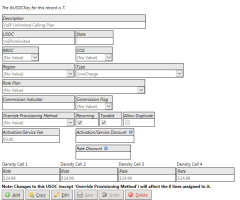USOC Data Field Definitions
| Field | Definition | Notes |
| Description | The description is user defined and will be displayed on the end user's invoice | *Can be overridden when added to a specific product |
| USOC |
The USOC code is a way to identify a USOC. For CLEC's and Resellers, these are generally defined by the underlying carrier. Alternatively, the USOC code can be set individually at the company level. |
|
| State | The state field, if filled, will be used when adding a new Master USOC to a Local Line. TBS will filter down the list of available USOCs based on the State of the Local Line. | |
| RBOC | The RBOC (Regional Bell Operating Company) field, if filled, will be used when adding a new Master USOC to a Local Line. TBS will filter down the list of available USOCs based on the RBOC of the Local Line | |
| COS | The COS (Class of Service) field, if filled, will be used when adding a new Master USOC to a Local Line. TBS will filter down the list of available USOCs based on the COS of the Local Line. | Impacts Taxing. Taxes may differ based on Business or Residential product types. |
| Region | The Region field, if filled on the Local/VoIP product, will be used when adding a new Master USOC to a Local Line. TBS will filter down the list of available USOCs based on the user defined Region of the Local Line | |
| Type | Type is a system defined drop down list that allows users to classify the charge for Taxing purposes. |
Impacts Taxing. This type combined with the Product Line Type will determine exactly how this USOC charge will tax. PTT strongly recommends reviewing USOC Types with Client tax compliance representatives. Please be sure to review Taxing in TBS for more information. |
| Rate Plan |
The Rate Plan field allows users to set a "Default" rate plan on the local line when the Master USOC is added to the line. This default rate will only be set if the Local Line does NOT already have an existing Rate Plan set.
Setting of the Default Rate Plan works in conjunction with Rate Code Defaults which provides the ability to default the Local Rate Code based on some criteria. For example, giving all customers in WV the same Rate Code regardless of the Master USOCs. |
|
| Commission Indicator | Indicator used for Local commissions. | Impacts Commissions |
| Commission Flag | Yes / No flag to indicate if this USOC should be included in any commission calculations | Impacts Commissions |
| Override Provisioning Method | The Override Provisioning Method is used to set the Provisioning Method on the Local Line. TBS provides the ability to set Provisioning Method based on the State, RBOC, COS, and Density Cell (See Admin->Local->Local Info). This field will override the Local Line Provisioning Method when the Master USOC is added to the line. | |
| Recurring | The Recurring Flag is used by the Billing Engine to determine if the Master USOC is a One Time Charge or a Recurring Charge | |
| Taxable | The Taxable Flag is used by the Billing Engine to determine if the Master USOC is taxable. | |
| Allow Duplicate | The Allow Duplicate Flag, when checked, will allow users to enter the same Master USOC to a local line. By default, this is not allowed to prevent the accidental addition of duplicate charges. | |
| Activation Fee | The Activation Fee is a charge that will be applied only once, when the Master USOC is first billed on a local line. | *Can be overridden when added to a specific product |
| Activation Discount | The Activation Discount provides a way to discount the Activation Fee. | *Can be overridden when added to a specific product |
| Rates 1 to 4 |
This is the main Rate for the USOC. For Local Products, rates may be different based on Local Density of the product. For VoIP Products, all Rates should be the same in all 4 textboxes. |
*Can be overridden when added to a specific product |
![]() There are a few important notes about how the system handles changes to existing Master USOCs:
There are a few important notes about how the system handles changes to existing Master USOCs:
- Above the command buttons is a bold note that shows how many lines this USOC is attached too. Any changes to the USOC (except the Override Provisioning Method) will impact all of these lines. For example, if a rate is changed from $1.00 to $2.00, then all lines with that USOC will be charged $2.00 during the next bill run.
